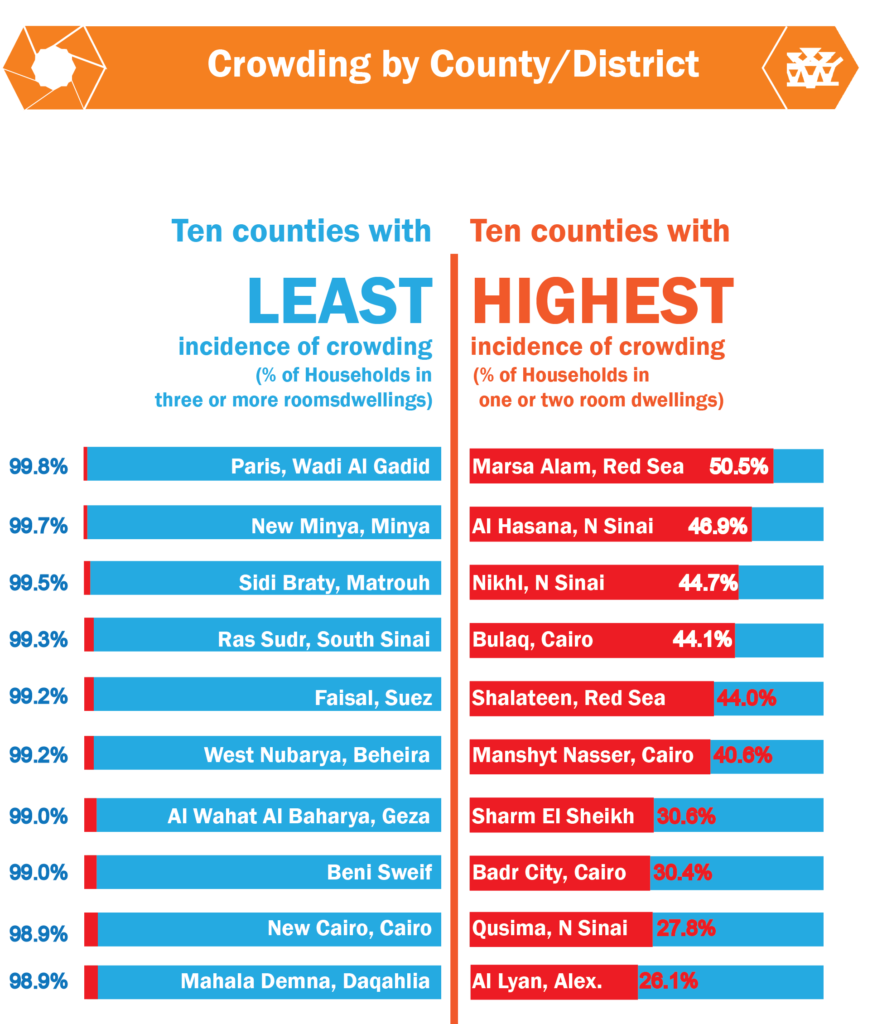Crowding
Table of Contents

Summary
About 7.7% of Egypt’s population live in extremely crowded conditions (one or two room dwellings).[1] Most of this housing is permanent and may be: standalone shacks; porter or guard’s rooms; old emergency housing; large homes subdivided into rooms; basement rooms and roof top rooms. Besides the social and health risks associated with crowding, an unspecified proportion of this type of housing relies on shared toilets and bathing facilities, exposing children and women to harassment and abuse.
How is overcrowding a problem?
Overcrowding has a direct impact on the health and social life of human beings. Crowding generally refers to people’s psychological response to density. The World Health Organization (WHO) considers crowding as one of the major factors affecting human health as the crowding of persons into a small space promotes the rapid spread of infection, especially with children.[2] Overcrowding also causes many social problems such as lack of privacy and possible sexual harassment.
A survey of more than 500 overcrowded households living in social housing in England showed that 92 % of overcrowded families stated that lack of privacy harmed family relationships and caused fighting and arguing among their children, especially among the teenagers.[3] Moreover, the lack of privacy affects the relationships between the partners, as they lose their own private space due to sharing the same room with their own children.
Residents living in crowded conditions in Egypt have regularly complained about crowding. One woman wrote to the Minister of Housing asking for a social housing unit and expressing fears of sexual harassment at her own unit, where her daughters are forced to use a shared bathroom. [4]
Who lives in overcrowded conditions in Egypt?
Overcrowding is largely a phenomenon affecting the urban poor. The Greater Cairo metropolis alone (including the governorates of Cairo, Giza and Qalubia) is home to over half a million families (about two fifths of all families) that live in one or two room dwellings. Crowding also occurs in some rural or remote governorates: almost 15% of households in North Sinai, for example, live in overcrowded conditions.
Overcrowding affects mostly the poor: building porters (bawabs) allowed to live in-kind in rooms on the ground floor or in the garages of buildings; squatters living in self-built shacks; families sub-dividing large homes in decaying historic districts; builders living in barracks in remote construction sites; or evictees granted small government-built emergency housing.
Figure 1: Ten Least / Most Deprived Districts in Egypt

Source: CAPMAS 2008. 2006 Census of Population and Living Conditions. Number of Households by Number of rooms
Why do people live in overcrowded conditions?
The root cause of overcrowding in Egypt seems to be affordability. The gap between house prices and income is large.[5] Ultimately the smaller the dwelling, the cheaper it is to build, buy or rent.
Self-built housing on state-owned land by squatters is usually one or two room shacks, as they live in a precarious situation for years with the threat of demolition. Families in Mazarita, in the Cairo district of Basateen had no choice but to take out loans to build small rooms and share them with extended families due to the high (and still rising) cost of house rents. [6]
Informal developers capitalising on the influx of migrants to Cairo have purposely built small two room apartments with shared bathrooms (fig X). On the other hand large houses in historic inner-city districts have been subdivided into rooms that are rented out individually.
Government-built emergency housing, masakin iwa’, initially intended to be temporary, house tens of thousands of families decades after they were relocated there. Families forced to relocate from the Suez Canal cities in the wake of the 1967 war with Israel live in al-wahayed and al-etneinat (literally, “ones” and “twos” referring to the number of rooms) housing in the Cairo district of Manshiet Nasser where official statistics show that 11,600 and 15,634 families are living in one and two room housing respectively. A staggering 30% of families in Badr City, a satellite district east of Cairo, live in the Zilzal (literally earthquake) neighbourhood where survivors of the 1992 earthquake were re-housed. Over 46,000 new government-built housing units built over the last ten years called al-Awla bil-Ri’aya (the most needy), [7] offer single room, one bedroom and two bedrooms units ranging in size from 18 to 43 square meters.[8] This leads to serious overcrowding. These units are rented out to those too poor to afford mainstream social housing, or those relocated from slum clearance operations.
Building porters live rent-free in the city along with a small salary in exchange for security and cleaning. The rooms are commonly occupied by the porter, his spouse, and a number of their children as well as extended family. Even though the district of New Cairo is seen as up-scale, it had a high incidence of crowding where 9.7% of households living there were found to be occupying one-room dwellings. There is little doubt that this represents porters.
Agricultural workers and builders on large projects are routinely housed in barrack-style rooms or camps on construction sites (fig X). The census for markaz Toshka in Aswan, a large-scale agricultural land reclamation project, showed that the entire population there of 2655 people were living in 18 dormitory style buildings: hostels, workers’ barracks or shacks.[9]
What can be done?
- Improving affordability of adequate housing.
- Introducing a programme to provide private bathrooms to all households living in permanent housing units whether through addition of bathrooms or the voluntary relocation to new housing units.
- Halting new government-built housing that leads to crowding
- Prioritising families that live in crowded conditions when allocating government housing aid
Methodology
Definition of Crowding
Crowding is always confused with density. In fact, however, they are two different terms. “Density measures the number of people in any given space, while crowding generally refers to people’s psychological response to density, that is, to their feelings of being crowded, having a lack of privacy or an increase in unwanted interactions or psychological distress”.[10] Given this definition, we will examine the phenomenon of crowding on the individual dwelling level.
Quantitative Measurement of Crowding
Crowding measurement tools vary from country to country and from one organization to another. What follows is a review of the major tools used to measure crowding;
- Person per room rate: This is the most widely used indicator to measure crowding. However, it is a bit problematic being unclear as to what should be considered a room in the different housing designs and layouts, It also ignores the different sizes of the rooms. For example, the European Union counts all the rooms except the kitchen. On the other hand, Sweden does not count the kitchen and the living room. Furthermore the person per room rate does not differentiate between age and sex in the sleeping arrangements, which differ among cultures. For instance the acceptable person per room rate in New Zealand is 1 to 2 persons per room, while in the United States and most European countries is 1 person per room.[11]
- Bedroom Occupancy: This is also used as a tool for measuring crowding as it calculates the ratios of the number of inhabitants relative to the number of bedrooms available in the house. Bedroom occupancy is preferred over the person per room rate since it takes into consideration the structure of the households as well as the layout of the house itself.[12]
- Bedroom Standard: This standard was developed in Britain and Canada and it takes into consideration the household structure, house size as well as social norms. This can be illustrated through The Canadian National Occupancy Standard, which assesses the number of bedrooms required by a household by specifying that:
- There should be no more than two persons per bedroom
- Children less than five years of different sexes may reasonably share a bedroom
- Children five years or older of opposite sex should not share a bedroom
- Children less than 18 years and of the same sex may reasonably share a bedroom
- Household members 18 years or over should have a separate bedroom, as should parents or couples.
Households living in dwellings where this standard cannot be met are considered to be overcrowded. [13]
Overcrowding
Both crowding and overcrowding are terms with negative connotations, but usually the term overcrowding is used to reflect high levels of crowding that in turn reflects on housing needs. For instance the National Housing Commission in New Zealand in 1998 described “overcrowding” as two or more families in the same household not by choice. The New Zealand ministry of housing on the other hand considered a house “seriously overcrowded” if there were more than 3 persons living in one bedroom. The Generalized Needs Index (GNI) and Housing Needs Index (HNI) in England considered overcrowding as more than one person per room and the “Severely overcrowded” households were those where either the average number of persons per room was greater than 1.5 or there were two fewer bedrooms than the bedroom standard.[14]
On the international level, UN-Habitat considers a house to be providing sufficient living area for the household members if three or less people share the same room[15], a standard that is considerably lower than the Western standards reviewed above.
Methodology for calculating crowding in Egypt
Based on our quantitative analysis of the crowding data published by the Central Agency for Public Mobilization and Statistics (CAPMAS) in 2006, and according to the international definitions and measurement tools of crowding, we found: that the acceptable crowding standard in Egypt would be less than 1.5 persons per room; medium crowding to be between 1.5 and 1.7 persons per room; and overcrowding to be more than 1.8 persons per room (Table x).
Table 1: Range of crowding rates (persons per room) based on different dwelling and household scenarios. Yellow represents moderately corded conditions, and red severe.
| Number of Habitable Rooms | |||||
| Persons per household | 1 | 2 | 3 | 4 | 5 |
| 1 | 1.0 | 0.5 | 0.3 | 0.3 | 0.2 |
| 2 | 2.0 | 1.0 | 0.7 | 0.5 | 0.4 |
| 3 | 3.0 | 1.5 | 1.0 | 0.8 | 0.6 |
| 4 | 4.0 | 2.0 | 1.3 | 1.0 | 0.8 |
| 5 | 5.0 | 2.5 | 1.7 | 1.3 | 1.0 |
| 6 | 6.0 | 3.0 | 2.0 | 1.5 | 1.2 |
The 2006 census also gave us a good opportunity to measure crowding. Families were tallied according to the number of habitable rooms in their dwelling. We designated all one and two room dwellings as overcrowded, and used both household numbers and percentages in the indicator.
Qualitative Concerns: Crowding and Health issues
The World Health Organization (WHO) Expert Committee on the Public Health Aspects of Housing states:
One of the fundamentals of a healthful residential environment should be a safe and structurally sound, adequately maintained, separate, self-contained dwelling unit for each household if so desired, with each dwelling unit providing at least the following:
- A sufficient number of rooms, usable floor area and volume of enclosed space to satisfy human requirements for health and for family life, consistent with the prevailing cultural and social pattern of that region and so utilized that living or sleeping rooms are not overcrowded
- At least a minimum degree of desired privacy:
- for individual persons within the household
- for members of the household against undue disturbance by external factors
- Suitable separation of rooms as used for:
- Sleeping by adolescent and adult members of the opposite sex except husband and wife
- Housing of domestic animals apart from the living room of the dwelling unit.
These needs can be expressed in terms of space requirements to perform household activities and/or occupancy standards.[16]
Those requirements were established because crowding is considered one of the major elements affecting human health. The crowding of persons into a small space promotes the rapid spread of infection, especially among children. Therefore, the World Health Organization (WHO) Expert meeting in 2010 recommended that International guidance on “healthy housing” should be developed to help prevent a wide range of diseases and unintentional injuries that can be effectively addressed through better housing.[17]
Footnotes
[1] CAPMAS 2008. 2006 Census of Population and Living Conditions. Number of Households by Number of rooms. [2] World Health Organization. (2010). Developing guidance for health protection in the built environment - mitigation and adaptation responses. Geneva . [3] Reynolds, L., & Robinson, N. (2005). Full house?How overcrowded housing affects families. London: Shelter. [4] El Shourouk Newspaper . (2016, April 19). 9 Rostom Street. Retrieved May 18, 2016, from El Shourouk Newspaper : http://www.shorouknews.com/news/view.aspx?cdate=19042016&id=ba5d598d-8dad-4546-985c-0193cdd7f94f [5] See the Affordability Indicator [6] Shadow Ministry of Housing). Mazarita, Basateen, Cairo [Documentary] https://www.youtube.com/watch?v=6REKyxkkKQM [7] Shawkat, Y. (2014) Mubarak’s Promise. Social justice and the National Housing Programme: affordable homes or political gain?, Égypte/Monde arabe, Troisième série, 11 | 2014, 9 April 2014. http://ema.revues.org/3318 [8] Arab Contractors. Housing Projects. Housing for Most Favored Families. n.d. https://web.archive.org/web/20160920160916/http://www.arabcont.com/English/projects/project-449.aspx Accessed 20.09.2016 [9] The 2006 Census for Madinet Toshka al-Gadida in Aswan, showed only 2655 people all living in masakin ‘amma (general buildings) rather than dwellings. CAPMAS 2008. 2006 Census of Population and Living Conditions. [10] Gray, A. (2001). Definitions of Crowding and the Effects of Crowding on Health:A Literature Review. Gray Matter Research Ltd. [11] Gray, A. (2001). Definitions of Crowding and the Effects of Crowding on Health:A Literature Review. Gray Matter Research Ltd. [12] Gray, A. (2001). Definitions of Crowding and the Effects of Crowding on Health:A Literature Review. Gray Matter Research Ltd. [13] Gray, A. (2001). Definitions of Crowding and the Effects of Crowding on Health:A Literature Review. Gray Matter Research Ltd. [14] Gray, A. (2001). Definitions of Crowding and the Effects of Crowding on Health:A Literature Review. Gray Matter Research Ltd. [15] United Nations Human Settlements Programme (UN-Habitat). (2004, August). Urban Indicators Guidelines. Monitoring the Habitat Agenda and the Millennium Development Goals. [16] World Health Organization. (1961). Expert Committee On The Public Health Aspects Of Housing, First Report . Geneva. [17] World Health Organization. (2010). Developing guidance for health protection in the built environment - mitigation and adaptation responses. Geneva .

